You searched for: Theresienstadt
<< Previous | Displaying results 51-100 of 207 for "Theresienstadt" | Next >>
-
Scene from a Nazi propaganda film in Theresienstadt
PhotoIn a scene from a Nazi propaganda film, Dr. Paul Eppstein (right), Council of Elders chairman, addresses Dutch Jews. Theresienstadt ghetto, Czechoslovakia, August 1944.

-
Theresienstadt ration card issued to Alice Winternitz (front)
DocumentThe Nazis made Jewish leaders responsible for the distribution of food supplies and other necessities allotted to ghetto residents. Due to grossly inadequate supplies, the Juedische Selbstverwaltung Theresienstadt (Jewish Administration of Theresienstadt) issued ration cards such as this one. The columns count points allotted for various goods identified by letters of the alphabet. Boxes were removed as residents exchanged points for food or other goods. This view shows the front of the card. Issued in the…
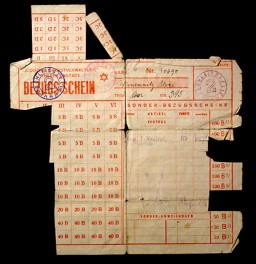
-
Deportation of German Jews to Theresienstadt
PhotoScene during the deportation of German Jews to Theresienstadt ghetto. Jewish deportees from the Hanau, Gelnhausen and Schluechtern districts wait with their luggage on the platform at the Hanau station before boarding the deportation train. Hanau, Germany, May 30, 1942.
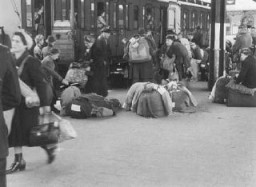
-
Czech Jews are deported from Bauschovitz to Theresienstadt ghetto.
PhotoCzech Jews are deported from Bauschovitz to Theresienstadt ghetto. Czechoslovakia, between 1941 and 1943.
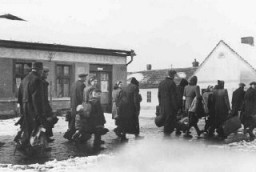
-
Hana Mueller Bruml describes the vibrant cultural life in the Theresienstadt ghetto
Oral HistoryIn 1942, Hana was confined with other Jews to the Theresienstadt ghetto, where she worked as a nurse. There, amid epidemics and poverty, residents held operas, debates, and poetry readings. In 1944, she was deported to Auschwitz. After a month there, she was sent to Sackisch, a Gross-Rosen subcamp, where she made airplane parts at forced labor. She was liberated in May 1945.

-
Hana Mueller Bruml describes her deportation to and arrival at Theresienstadt
Oral HistoryIn 1942, Hana was confined with other Jews to the Theresienstadt ghetto, where she worked as a nurse. There, amid epidemics and poverty, residents held operas, debates, and poetry readings. In 1944, she was deported to Auschwitz. After a month there, she was sent to Sackisch, a Gross-Rosen subcamp, where she made airplane parts at forced labor. She was liberated in May 1945.

-
Hana Mueller Bruml describes black market activity in the Theresienstadt ghetto
Oral HistoryIn 1942, Hana was confined with other Jews to the Theresienstadt ghetto, where she worked as a nurse. There, amid epidemics and poverty, residents held operas, debates, and poetry readings. In 1944, she was deported to Auschwitz. After a month there, she was sent to Sackisch, a Gross-Rosen subcamp, where she made airplane parts at forced labor. She was liberated in May 1945.
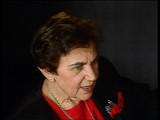
-
Painting of the Vltava River in Prague by Theresienstadt prisoner Bedrich Fritta
Photo1943 painting of the Vltava River in Prague created from a photograph by Bedrich Fritta when he was imprisoned in Theresienstadt. Fritta (1909-1945) was a Czech Jewish artist who created drawings and paintings depicting conditions in the Theresienstadt camp-ghetto. Fritta was deported to Auschwitz in October 1944. He died there a week after his arrival.
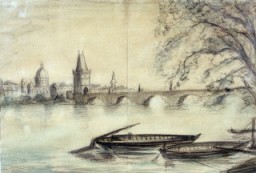
-
1943 portrait of Edgar Krasa drawn by Leo Haas in Theresienstadt
Photo1943 portrait of Edgar Krasa drawn by Leo Haas in Theresienstadt. Haas (1901-1983) was a Czech Jewish artist who, while imprisoned in Nisko and Theresienstadt during World War II, painted portraits and produced a large volume of drawings documenting the daily life of the prisoners.
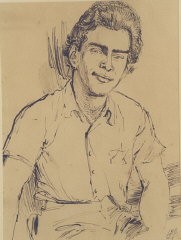
-
Hana Mueller Bruml describes preparations for a Red Cross visit to Theresienstadt
Oral HistoryIn 1942, Hana was confined with other Jews to the Theresienstadt ghetto, where she worked as a nurse. There, amid epidemics and poverty, residents held operas, debates, and poetry readings. In 1944, she was deported to Auschwitz. After a month there, she was sent to Sackisch, a Gross-Rosen subcamp, where she made airplane parts at forced labor. She was liberated in May 1945.

-
Deportation from Hanau
PhotoDeportation of German Jews from Hanau to Theresienstadt. Hanau, Germany, May 30, 1942.

-
Deportation of German Jews from Hanau
PhotoDeportation of German Jews from the train station in Hanau to Theresienstadt. Hanau, Germany, May 30, 1942.

-
The Holocaust in Bohemia and Moravia
ArticleLearn about the Holocaust in the Protectorate of Bohemia and Moravia, including deportations to and from the Theresienstadt camp-ghetto.
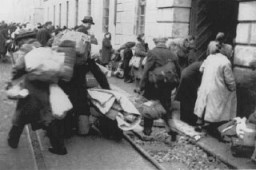
-
Bertha Wolffberg Gottschalk
ID CardBertha was born to Jewish parents in the capital of East Prussia. Her father served on the Koenigsberg city council. In 1887 Bertha married Hugo Gottschalk, and the couple settled in the small town of Schlawe in northern Germany. There, Hugo owned the town's grain mill. The Gottschalks raised their four children in a home near a small stream, ringed by orchards and a large garden. 1933-39: Bertha and her daughter Nanny have moved to Berlin--Hugo passed away in 1934 and they were afraid of the growing…
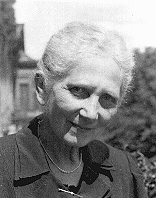
-
Deceiving the Public
ArticleThe Nazis frequently used propaganda to disguise their political aims and deceive the German and international public. Learn more.

-
Max Krakauer
ID CardMax was the oldest of six children born to Jewish parents in the small Moravian town of Hodonin, where his father ran a dry-goods and clothing store. His family spoke both Czech and German at home, and Max attended German-language schools in Hodonin and Lipnik. He completed his education in 1920. Born with a heart condition, Max lived a sheltered life. 1933-39: Max's father, Bernard, was getting on in years and wanted to retire. Max was not strong enough to take over the business, so the Krakauers sold…

-
Bertha Falkenstein
ID CardOne of two children, Bertha grew up in the small village of Bergheim where her father was a farmer. After she married Leo Falkenstein, the couple settled in Hochneukirch, 20 miles northwest of Cologne. There her husband was employed in his father's cigar manufacturing business, "Isak Falkenstein and Sons." Bertha and Leo had six children whom they raised in the Jewish faith. 1933-39: In 1937 Bertha's daughter Johanna brought her two girls to live briefly with them in Hochneukirch. Johanna's husband, Carl,…

-
Bernard Krakauer
ID CardBernard was one of seven children born to a German-speaking, Jewish family in the small Moravian town of Mikulov in the central part of Czechoslovakia. The family later moved to the town of Hodonin where Bernard opened a dry-goods and clothing store. In 1899 he married Berta Koselova, and the couple had six children. During World War I Bernard served in the Austro-Hungarian army. 1933-39: In 1938 Bernard retired, and since none of his sons wanted to take over the business, Bernard sold it. He, his wife,…
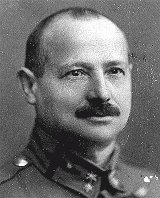
-
Zdenka Popper
ID CardZdenka was one of four children born to a Jewish family in Kolinec, a southwestern Bohemian town near the German border. Her father was a farmer and a lumber and grain merchant. Situated in the foothills of the Bohemian Forest, Kolinec was surrounded by rolling hills. Zdenka attended business school in the nearby town of Klatovy and, in 1927, moved to Prague with her uncle. 1933-39: Zdenka remembers how worried her mother was about the rise of German antisemitism in 1932. After listening to a radio…
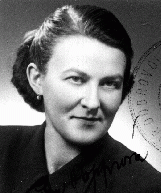
-
Ruth Gabriele Silten
ID CardGabriele was the only child of Jewish parents living in the German capital of Berlin. Her grandfather owned a pharmacy and a pharmaceuticals factory, where Gabriele's father also made his living. 1933-39: In 1938 the Nazis forced Ruth's grandfather to sell his factory and pharmacy for very little money to an "Aryan" German. After that, her father decided they should move to Amsterdam where it was safer for Jews. She was 5 years old and wanted to stay in Berlin. She didn't understand why she had to leave…
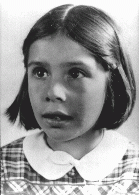
-
Fritz Silten
ID CardFritz was the youngest of two sons born to a Jewish family in the German capital of Berlin. In the late 1920s he earned a doctorate in chemistry and pharmacy. In 1931 he married Ilse Teppich, and in 1933 the couple had a daughter, Gabriele. 1933-39: Fritz worked in his father's pharmacy until 1938, when the Nazis forced them to sell the business for a fraction of its value to an "Aryan" German [Aryanization]. Leaving his parents behind was agonizing, but concern for the safety of his wife and daughter…
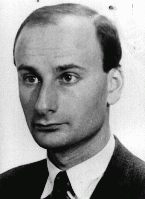
-
Ilse Silten
ID CardIlse, born Ilse Teppich, was the eldest of two daughters born to a Jewish family in the German capital of Berlin. Her father owned a dry cleaning business in the city. When Ilse finished secondary school, she was sent to a finishing school in Switzerland where she studied to be a photographer. In 1931 she married Fritz Silten. 1933-39: In 1933 Ilse gave birth to the couple's only child, a daughter named Gabriele. Five years later, when Fritz's father was forced by the Nazis to sell his business for a…
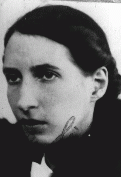
-
Leo Falkenstein
ID CardOne of three children, Leo grew up in the small town of Hochneukirch, 20 miles northwest of Cologne. As an adult, Leo entered his father's cigar manufacturing business, "Isak Falkenstein and Sons." Leo and his wife, Bertha, lived in a house next to Leo's parents. Leo and Bertha had six children whom they raised in the Jewish faith. 1933-39: Leo and Bertha's daughter Johanna has brought her two girls to live with them for a while here in Hochneukirch. Johanna's husband, Carl, has been having trouble…

-
Berta Koselova Krakauerova
ID CardBerta was born to a Jewish family. Orphaned when she was a child, she was raised by her Uncle Poldi in Vienna. In 1899 she married Bernard Krakauer, a Jewish businessman from her hometown of Mikulov. As was the custom for orphans, Berta wore a black dress at her wedding. The couple settled in the town of Hodonin, where Bernard opened a dry goods and clothing store. They raised six children. 1933-39: With their children grown, Berta's husband retired in 1938. He sold the business and moved with Berta and…

-
Peter Winternitz
ID CardPeter was the oldest of two children born to a Jewish family in the Czechoslovakian capital of Prague, a city with a Jewish community that dated back to the eleventh century. His family lived on Karlova Street in the city's Karlin district. Peter's father owned a wholesale business that sold floor coverings. 1933-39: As a boy, Peter was active in a Zionist sports organization, Maccabi Ha-Zair. The group also helped prepare youth to immigrate to Palestine [Aliyah Bet] by training them in agricultural work.…
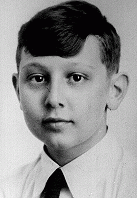
-
Ida Edelstein
ID CardIda, born Ida Kohn, was the oldest of four children born to a Jewish family in the village of Hostoun, near Prague. Her father owned a grocery store in the village, and also recorded the birth, death and marriage certificates in the Jewish community. In 1912 Ida married Josef Edelstein and they moved to Vienna. By 1920 the couple had a son, Wilhelm, and a daughter, Alice. 1933-39: In March 1938 the Germans annexed Austria. In the next few weeks, Ida, along with other Jews, was forced to scrub sidewalks.…
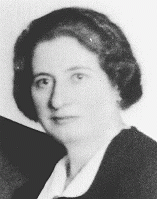
-
Robert Kulka
ID CardRobert was the son of Jewish parents, Leopold and Florentina Kulka, and was raised in the Moravian town of Olomouc. After completing secondary school, he attended a business school until 1909. He began a business in Olomouc and in 1933 he married Elsa Skutezka from the Moravian city of Brno. The couple made their home in Olomouc. 1933-39: The Kulkas' son, Tomas, was born a year and a day after they were married. In 1937 Elsa's father passed away and the Kulkas moved to Brno, where Elsa and her husband…
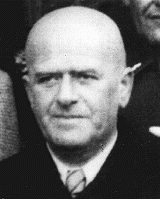
-
Alice Krakauerova Seelenfriedova
ID CardAlice was the third of six children born to Jewish parents in the small Moravian town of Hodonin, where her father ran a dry goods and clothing store. The family spoke both Czech and German at home, and Alice attended a German-language secondary school. After graduating, she married her teenage sweetheart, Otto Seelenfried, who was a chemical engineer. 1933-39: Alice and Otto moved to the town of Jihlava. In 1934 Otto died from a ruptured appendix, and Alice returned to live with her parents in Hodonin.…
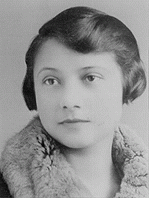
-
Johanna Falkenstein Heumann
ID CardThe oldest of five children, Johanna was born to Jewish parents living in a small town near Cologne. Her father owned a cigar factory. After Johanna graduated from high school, she worked in a bank in Cologne. At 22 she married Carl Heumann and the couple settled in the village of Hellenthal near the Belgian border. There they owned a general store. The couple had two daughters, Margot and Lore. 1933-39: A year ago Johanna's family moved to nearby Bielefeld, and she enrolled Margot and Lore in the city's…
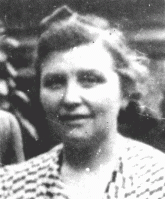
-
Lisl Winternitz
ID CardLisl was the youngest of two children born to a Jewish family in the Czechoslovakian capital of Prague, a city with a Jewish community that dated back to the eleventh century. Lisl's family lived on Karlova Street in the Karlin district of the city. Lisl's father owned a wholesale business that sold floor coverings. 1933-39: Lisl was 12 when, on March 15, 1939, the German occupation forces entered Prague. She went to school that day and a teacher shouted at her, "You dirty, filthy Jew," and then spat in…
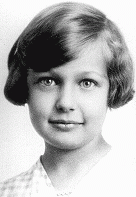
-
Deportation of Jews from Plzen
PhotoDeportation of Jews from Plzen (Pilsen) to Theresienstadt. The building in the background is the town theater. Czechoslovakia, 1942.

-
Children's painting showing Jews celebrating Hannukah
PhotoChildren's painting showing of Jews celebrating Hannukah. This painting, which was probably drawn by either Michael or Marietta Grunbaum, was made in Theresienstadt and then pasted into a scrapbook by their mother shortly after liberation. Theresienstadt, Czechoslovakia, ca. 1943.
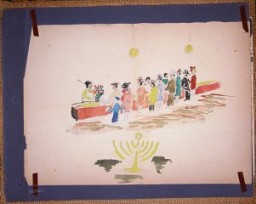
-
Alice (Lisl) Winternitz's luggage tag
ArtifactThis paper tag identified bedding belonging to Alice (Lisl) Winternitz when she was deported from Prague, Czechoslovakia, to the Theresienstadt ghetto in June 1942.
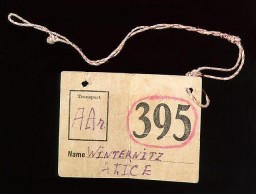
-
Red triangle patch worn by a Czech political prisoner
PhotoRed triangle patch worn by Czech political prisoner Karel Bruml in Theresienstadt. The letter "T" stands for "Tscheche" (Czech in German).

-
Helene Reik's diary
Media EssayDiaries reveal some of the most intimate, heart-wrenching accounts of the Holocaust. They record in real time the feelings of loss, fear, and, sometimes, hope of those facing extraordinary peril. Written on postcard...
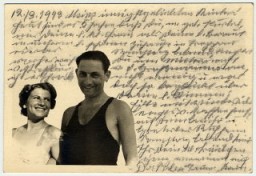
-
1943 still life of a violin and sheet of music behind prison bars by Bedrich Fritta
Photo1943 still life of a violin and sheet of music behind prison bars by Bedrich Fritta (1909–1945). Fritta was a Czech Jewish artist who created drawings and paintings depicting conditions in the Theresienstadt camp-ghetto. He was deported to Auschwitz in October 1944; he died there a week after his arrival.
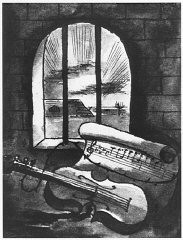
-
Inge Auerbacher
ID CardInge was the only child of Berthold and Regina Auerbacher, religious Jews living in Kippenheim, a village in southwestern Germany near the Black Forest. Her father was a textile merchant. The family lived in a large house with 17 rooms and had servants to help with the housework. 1933-39: On November 10, 1938, hoodlums threw rocks and broke all the windows of Inge's home. That same day police arrested her father and grandfather. Inge, her mother and grandmother managed to hide in a shed until it was…
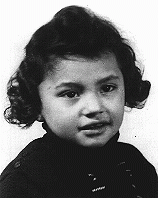
-
Anna Pfeffer
ID CardAnna, affectionately known as Aennchen to her family, was the daughter of non-religious German-Jewish parents. Her father died when she was young and Anna was raised in the town of Bruchsal by her impoverished mother. Anna married a well-to-do, older gentleman in 1905 and moved to the fashionable city of Duesseldorf, where he was a department store manager. By 1933 they had two grown sons. 1933-39: The Pfeffer's comfortable life unraveled after the Nazis came to power. The Nazis arrested Anna's brother…
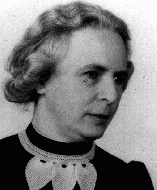
-
Hana Müller
ID CardHana was born to a Jewish family in Prague, the capital of Czechoslovakia. Her father, a metalsmith, made pipes, spouts and gutters for construction companies. Because her mother was frail, Hana was raised by her father and grandmother. She attended a Jewish school through grade five, and later went to business school. 1933-39: In 1933 Hana read about the harrowing treatment of Jews during the Spanish Inquisition and told her grandmother, "Aren't we fortunate that we live in the 20th century in…

-
Alfred (Fredl) Krakauer
ID CardAlfred was the fifth of six children born to Jewish parents in a small town in Moravia, where his father ran a dry-goods and clothing store. The Krakauers spoke both Czech and German at home. In 1929 and 1930, after graduating from secondary school, Alfred served in the Czechoslovakian army. He enjoyed skiing and also played soccer for the Maccabi Jewish team. 1933-39: Alfred graduated in 1934 from Prague's Industrial School for Art. He became a graphic artist and decided to remain in Prague because of…
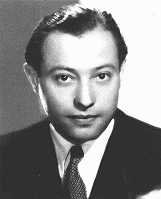
-
Leo Nitschke
ID CardLeo was one of two children born to Jewish parents in the Moravian capital of Brno. When Leo was a child his father died, and Leo and his sister, Edita, were raised by their German-born mother. On November 27, 1931, Leo graduated with a law degree from Brno University. 1933-39: After courting Hilda Krakauerova, a dental technician, Leo married her on December 23, 1935. Leo served as a district judge in Brno and in the town of Postejov, and in 1938 he was appointed judge and secretary to the Moravian…
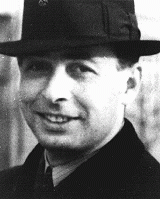
-
Last Diary Entry Written by Otto Wolf
Timeline EventApril 13, 1945. On this date, Otto Wolf, a teen diarist who chronicled his family's experience in hiding, wrote his last diary entry before his death.

-
Photograph of the water tower of the Old Town Mills in Prague
PhotoPhotograph of the water tower of the Old Town Mills in Prague. After her deportation to the Theresienstadt ghetto in Czechoslovakia, Helene Reik yearned to record what was happening to her. This photograph was sent to Helene, who used it as paper for her diary in Theresienstadt. Helene’s makeshift diary offers wistful memories of her husband and parents who died before the war, loving thoughts of her family who had left Europe in 1939, and a firsthand account of the illness and hospitalization that…
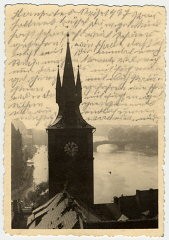
-
Photograph taken in May 1915 of Helene Reik's children
PhotoPhotograph taken in May 1915 of Helene Reik's children. After her deportation to the Theresienstadt ghetto in Czechoslovakia, Helene yearned to record what was happening to her. This photograph was sent to Helene, who used it as paper for her diary in Theresienstadt. Helene’s makeshift diary offers wistful memories of her husband and parents who died before the war, loving thoughts of her family who had left Europe in 1939, and a firsthand account of the illness and hospitalization that ultimately…
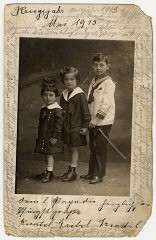
-
Photograph showing Margarida, Helene Reik's granddaughter, in Brazil
PhotoPhotograph showing Margarida, Helene Reik's granddaughter, playing on a field in Teresopolis, Brazil, in April 1940. After her deportation to the Theresienstadt ghetto in Czechoslovakia, Helene yearned to record what was happening to her. This photograph was sent to Helene, who used it as paper for her diary in Theresienstadt. Helene’s makeshift diary offers wistful memories of her husband and parents who died before the war, loving thoughts of her family who had left Europe in 1939, and a firsthand…

-
Beno Helmer
ID CardBeno was the oldest of three children in a Jewish family. His mother, originally from Austria, came to Czechoslovakia after World War I. Beno's father, a Swedish Jew, arrived there in search of work and became a successful merchant. The German-speaking Helmer home was frequently full of guests. Every day some students from the local rabbinical academy were invited to join the family for a meal. 1933-39: Beno's parents sent him to Budapest to attend high school. Later, because of his talent with languages,…
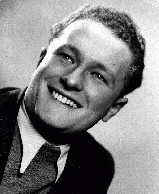
-
Boleslaw Brodecki
ID CardRaised by religious Jewish parents, Boleslaw and his older sister grew up in an apartment complex in a Jewish section of Warsaw. His father worked as an accountant. When Boleslaw was 8 years old, his mother died, and an aunt moved in to help raise him and his sister. Boleslaw loved electronics. When he was 10 years old, he succeeded in building a portable radio. 1933-39: The Germans attacked Warsaw on September 8, 1939. The bombing was relentless. Boleslaw's father wouldn't leave his ill relatives but…
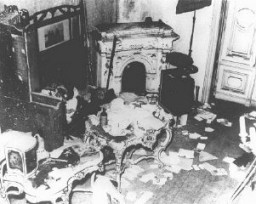
-
Judith Gabriel Dichter
ID CardJudith, nicknamed Julie, was one of five children born to religious Hungarian-Jewish parents in the Burgenland, the eastern province of Austria that was part of Hungary until 1921. She married Tobias Dichter, a traveling salesman from Vienna who had sold merchandise to her father. The Dichters moved to an apartment in Vienna's Jewish Leopoldstadt district, where they raised two children. 1933-39: The Germans have annexed Austria. One week after the annexation, Germans came to Julie's apartment to take her…
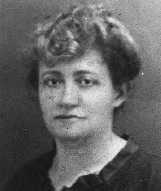
-
Magda Rein
ID CardMagda was the oldest of two children born to observant Jewish parents. They lived in Satoraljaujhely, a town in northeastern Hungary on the Czechoslovakian border. Jews represented some 20 percent of the town's approximately 18,000 persons. Magda's father owned a bakery; her mother was a midwife. 1933-39: At 10 years of age, Magda began accompanying her mother when she attended to births nearby. Her mother helped all women--Jews, Roma (Gypsies) and peasants in the surrounding villages. When Magda was 12,…

